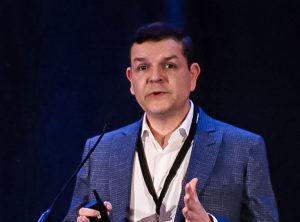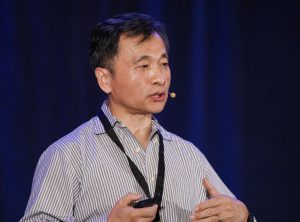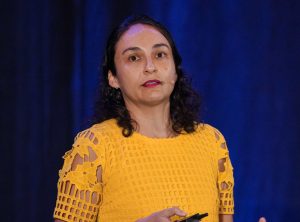This article is part of an extensive feature on the 2024 HAEi Regional Conference Americas, published in Global Perspectives #1 2024
 HAE in women and pregnancy, Prof. Anete Grumach
HAE in women and pregnancy, Prof. Anete Grumach
Prof. Grumach spoke first. She told the audience that most studies and registries show that women are more severely affected by HAE. Studies indicate between 56-75% of cases in registries around the world are women.
The main reason for this is estrogen production, which is, of course, a big issue in pregnancy. Additionally, oral contraception containing estrogen can be a trigger for attacks. Prof. Grumach explained that estrogen can be the trigger for attacks as it can lead to decreases in C1 inhibitor production.
Prof. Grumach presented case studies of HAE patients and their experiences with pregnancy and childbirth. She showed the audience data from a study of HAE pregnancies in Turkey. It indicated that pregnancy-related complications such as pre-term labor, spontaneous abortion, and lower birth weight were similar to that seen in the general population.
In general, Prof. Grumach indicated that the frequency or severity of attacks during one pregnancy does not predict the risk of attacks in future pregnancies. She also counseled that labor and delivery rarely trigger angioedema.
In terms of treatment, Prof. Grumach made the following recommendations:
- Ensure access to acute HAE medication for use as needed
- In line with guidelines, use plasma-derived C1-inhibitor as the preferred therapy during pregnancy and lactation
- Consider the use of long-term plasma-derived C1-inhibitor as prophylactic treatment for women who need it or who will benefit from it
- There is a recommendation to use short-term prophylaxis for procedures, but normal delivery is not really a problem for the pregnant woman with HAE
- Have a plan of action or care plan which is based on shared decision-making
- Monitor HAE symptoms after birth because of potential increased risk of attacks. Remember that there will be hormone variations after the delivery and during breast-feeding
Prof. Grumach concluded her talk by telling the audience that HAE patients considering pregnancy to ensure access to treatment, be prepared, and ensure regular communication and monitoring with their doctor.
 HAE in children and the importance of family testing, Dr. Francisco Alberto Contreras-Verduzco
HAE in children and the importance of family testing, Dr. Francisco Alberto Contreras-Verduzco
Dr. Francisco Contreras spoke next on HAE in children and family testing.
He indicated that HAE attacks are very similar in children to that seen in adults. He said that attacks may occur at any time of life, but on average, the first attack occurs before the age of 10 with worsening symptoms during puberty. The most common attack triggers in children were mental stress and airway infection. The usually reported symptoms were colicky abdominal pain, nausea, vomiting, and diarrhea.
Dr. Contreras indicated that children’s smaller airways are a cause for concern in HAE as they can lead to rapid deterioration in laryngeal attacks.
Prodromal symptoms have been reported in almost 50% of cases, which can lead to misdiagnosis, particularly as urticaria.
Dr. Contreras mentioned that prospective parents may consider pre-natal (during pregnancy) diagnosis if HAE is already known in the family. This should be conducted with appropriate counseling and careful evaluation.
Blood complement testing, and values of C1-inhibitor are usually used. In general, he told the audience, genetic testing is really not necessary to confirm the diagnosis. In newborns this testing can be done using blood from the umbilical cord. Any testing of new borns should be repeated after a year in order to confirm a diagnosis, as blood values can change.
Moving to family testing, Dr. Contreras suggested that international guidelines recommend that children be tested for HAE if they are part of an affected family, that this should be carried out as soon as possible, and that all offspring of an affected parent should be tested.
 How patients benefit from clinical trials, Dr. Huamin Henry Li
How patients benefit from clinical trials, Dr. Huamin Henry Li
Dr. Huamin Henry Li was next up, taking the first of two clinical trial-related talks.
Dr. Li referenced HAEi’s own Tony Castaldo as a clinical trial participant. He told the audience that Tony takes part in trials, ‘Not only for me, but I have two daughters who suffer from HAE, and I have grandchildren. I want them to have a better life; they can have better treatment.’
So, this is one motivation, Dr. Li said. He made it clear that there are many different types of clinical trials. Some are related to treatment, but others consider other aspects of living with and caring for HAE. All of these are intended to improve the lives of people with HAE.
That said, Dr. Li conceded that the trials most people are interested in involve investigating a new treatment. This can mean that patients in these studies are able to access fascinating new treatments before they’re widely available while contributing to the knowledge of the disease state and treatment development.
Additionally, Dr. Li told the audience that participants in clinical trials often get much more comprehensive care, with more regular contact with experts. Your time and travel are also commonly covered for your participation.
Dr. Li concluded by saying that participating in clinical trials is hugely important. It allows access to cutting-edge medical treatment and expert care and also contributes to medical knowledge. He told the audience that most of his patients report that participating in clinical trials has benefitted them.
 Clinical trials: What can patients expect from taking part, Dr. Rosario Espinoza Mora
Clinical trials: What can patients expect from taking part, Dr. Rosario Espinoza Mora
Finally, Dr. Rosario Espinoza Mora spoke. She told the audience she was in charge of the clinical research department at her hospital. She explained the concept of ‘phases’ for new drug trials. These were, she said:
- Phase 1- to evaluate the toxicity of the new molecule, which is a candidate for becoming a new treatment
- Phase 2- you evaluate effectiveness and safety but in a small group of patients
- Phase 3- you continue evaluating safety and efficacy, but in a larger group of patients. After phase 3, the data is usually considered for approval by regulatory organizations such as the US FDA.
Dr. Mora told the audience that often (but not always) participating in a clinical trial can ensure access to that medication for a long time, even after the study itself finishes. It can be a highly valuable way to access treatment for HAE patients.
She encouraged people to look for information about trials and to consider researching trials that may be relevant to them. This information can be found in newspapers, official communications, flyers, websites, and even WhatsApp, which is used in Costa Rica.
Very importantly, Dr. Mora confirmed, that participation in a clinical trial is never obligatory for patients. Even if you have a good relationship with your physician or your caregiver, they must not pressure you to take part. They can, of course, attempt to recruit or persuade you, but the final decision is always yours. This is also important for children in clinical trials. Children can be recruited into clinical trials, but only with parental consent.
When researching clinical trials, Dr. Mora asked people to consider international clinical trial registries, such as clinicaltrials.gov. This is maintained by the US National Institutes of Health and covers almost all trials worldwide. She hoped that a similar system would be established in Latin America, but this is still under construction. She also suggested that pharmaceutical companies are a good data source on available trials.
Find more feature articles from the 2024 HAEi Regional Conference Americas:










